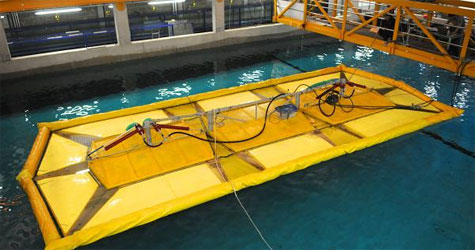Sea Wave Energy Ltd. (SWEL) is a new-entrant renewable energy business, focused on the marine sector.
It was established to exploit the intellectual property of its Waveline Magnet device, a wave energy converter that is the culmination of eight years’ research and development.
In March 2013, the latest version of the Waveline Magnet, the 12 metre long WM7, was tested in the new state-of-the-art wave tank at Plymouth University by independent marine energy experts and results confirmed that the WM7 was highly efficient at harnessing wave energy; see headline results below.
These tests followed on from an earlier set of tests carried out on the 9 metre WM6 device in Larnaca Bay, Cyprus by marine energy staff from the University of Exeter in July 2012. The tests confirmed that the Waveline Magnet device was not only suited to generating electricity but could also have additional commercial applications relating to seawater desalination and combatting coastal erosion by de-powering the waves.
As well as being highly efficient in terms of power conversion, its innovative design means that the device can be manufactured at very low cost per MW, when compared to other wave energy devices. The inventor calculates that 1MW of power can be achieved for less than £1.5m, as opposed to about £5m per MW that is a typical value in marine energy renewables.
Designing a device that is economically viable and can withstand the most adverse marine conditions, operating reliably for years on end, is the challenge facing all marine renewables engineers, but the team at SWEL are confident they have a solution that addresses these issues.
Commenting on SWEL’s innovative approach, Waveline Magnet inventor Adamos Zakheos said, “As the sea is a very hostile environment, most marine energy developers design heavy displacement devices in order to withstand the stormy conditions. We have done exactly the opposite. Our Waveline Magnet device is buoyancy-neutral and adheres to the surface of the water, so it follows precisely the contour of the wave as the wave passes ‘through’ the device,” he added.
“In this way, the Waveline Magnet presents minimum resistance to the force of the wave – whatever its size – and this not only enhances its ability to capture the power within the wave but also massively increases the survivability of the device,” he confirmed. www.swel.eu
The team at SWEL believes that the Waveline Magnet’s design offers the optimum solution in capturing as much of the wave’s available energy, at the lowest possible cost.
WM7 was tested in the Wave Tank at Plymouth University over two days on 5th– 6thMarch 2013 and delivered in excess of 1.3kW on a wave set duration of 2.5 seconds, at a wave height of just 60cm (24”).
From the test data, the inventor calculates that an array of ten full-sized Waveline Magnets, each one 200 metres in length and 50 metres wide, will deliver in excess of 15MW, enough energy to power at least 13,000 homes.
SWEL now plans to construct a new device, measuring 100m x 50m, single directional device (WM8) to be deployed at FaB Test, located in Falmouth Bay for further testing in the sea over a minimum period of six months to assess durability and record power outputs in a range of sea conditions.
It should be noted that the Waveline Magnet is modular in design, with the number of linked platforms determined by the prevailing wave profile, to deliver maximum power. Waveline Magnet devices can also be manufactured as a single or omni-directional device, to suit the prevailing sea conditions.
A second stage will be to construct a full size device the WM9 for deployment at Wavehub, the world’s largest grid connected test facility, where power can be brought ashore to Hayle in Cornwall via the undersea cable connector.
In order to fund the next stages of development, SWEL is seeking additional investment to carry this breakthrough technology forward. Interested parties should contact the directors by telephone or email.
Share your industry press now!
Are you a PR agency or sustainability-focused organization? Join the World of Renewables network FREE today and gain exclusive access to our platform to promote your business, share the latest industry news, and connect with a global audience of 700,000+ renewable energy professionals.
Register Now to start posting your updates and showcase your expertise to a highly engaged, environmentally-conscious community.
Find out more about our Content Partnership Programs.*2024 AWARD WINNER* Websites & Mobile Sites, Webby Winner, Peoples Voice 2024













